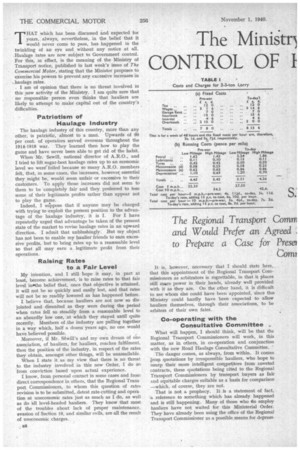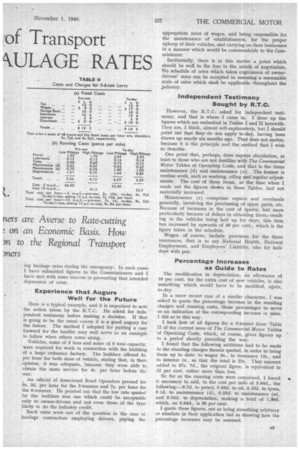The Minitr)
Page 26

Page 27

If you've noticed an error in this article please click here to report it so we can fix it.
of Transport
CONTROL OF I ULAGE RATES
HAT which has been discussed and expected for years, always, nevertheless, in the belief that it
• would never come to pass, has happened in the twinkling of an eye and without any notice at all. Haulage rates are now subject to Government control. For this, in effect, is the meaning of the Ministry of Transport notice, published in last week's issue of The Commercial Motor, stating that the Minister proposes to exercise his powers to prevent any excessive increases in haulage rates.
I am of opinion that there is no threat involved in this new activity of the Ministry. I am quite sure that no responsible person even thinks that hauliers are likely to attempt to make capital out of the country's difficulties.
Patriotism of Haulage Industry
The haulage industry of this country, more than any other, is patriotic, almost to a man. Upwards of 90 per cent. of operators served overseas throughout the 1914-1918 war. They learned then how to play the game and have never been able to get rid of the habit.
When Mr. Sewill, national director of A.R.O., and I tried to lift sugar-beet haulage rates up to an economic level we wer(foiled because so many A.R.O. members felt, that, in some cases, the increases, however, essential they might be, would seem unfair or excessive to their customers. To apply those increases did not seem to them to be completely fair and they preferred to lose some of their legitimate profits rather than appear not to play the game.
Indeed, I siippose that if anyone may be charged with trying to exploit the present position to the advantage of the haulage industry, it is I. For I have repeatedly urged that advantage be taken of the present state of the market to revise haulage rates in an upward direction. I admit that unblushingly. But my object has not been to enable my haulier friends to earn excessive profits, but to bring rates up to a reasonable level so that all may earn a legitimate profit from their operations.
Raising Rates . to a Fair Level
My intention, and I still hope it may, in part at least, become achievement, is to raise rates to that fair level inathe belief that, once that objective is attained, it will not be so quickly and easily lost, and that rates will not be so readily lowered as has happened before.
I believe that, because hauliers are not now so disjointed and disunited as they were during the period when rates fell so steadily from a reasonable level to an absurdly low one, at which they stayed until quite recently. Members of .the industry are pulling together in a way which, half a dozen years ago, no one would have believed possible.
Moreover, if Mr. S6Will's and my • own dream of one association, of hauliers, for hauliers, reaches fulfilment, then the position of the industry, in respect of the rates they obtain, amongst other things, will be unassailable.
When I state it as my view that there is no threat to the industry involved in this new Order, I do so from conviction based upon actual experience.
I know, from personal contact in some cases and from direct correspondence in others, that the Regional Trans port Commissioners, to whom this question of rates revision is to be submitted, detest rate-cutting and operation at uneconomic rates just as much as I do, as well as do all level-headed hauliers. They know that most of the troubles about lack of proper maintenance. evasion of Section 19, and similar evils, are all the result of uneconomic charges. It is, however, necessary that I should state here, , that this appointment of the Regional Transport Commissioners as arbitrators is regrettable, in that it places still mere power in their hands, already well provided with it as they are. On the other hand, it is difficult to see whom else could have been appointed, since the. Ministry could hardly have been expected to allow hauliers themselves, through their associations, to be arbiters of their own fates.
Co-operating with the Consultative Committee .
What will happen, I should think, will be that the Regional Transport Commissioners will work, in this matter, as in others, in co-operation and conjunction with the new Road Haulage Consultative Committee.
The danger comes, as always, from within. It comes frord quotations by irresponsible hauliers, who hope to usurp their more intelligent competitors from coveted cOntracts, these quotations being cited to the Regional Transport Commissioners by transport buyers as fair and equitable charges suitable as a basis for comparison -which, of course, they are not.
That is not a prophecy. It is a statement of fact, a reference to something which has already happened and is still happening. Many of those who do employ hauliers have not waited for this Ministerial Order. They have already been using the office of the Regional Transport Commissioner as a possible, means for depress ing haulage rates during the emergency. In such cases. I have submitted figures to the Commissioners and I have met with some success in preventing that intended depression of rates. .
• Experience that Augurs Well for the Future
Here is a typical example, and it is important to note the action taken by the R.T.C. He asked for independent testimony before making a decision. If that is going to be the usual course it is a good augury for the future. The method I adopted for putting a case forward for the hardier may well serve as an example to follow when others come along.
• Vehicles, some of 3 tons and some of 6 tons capacity, were required for work in connection with the building of a large ordnance factory. The builders offered 5s. per hour for both sizes of vehicle, stating that, in their opinion, it was adequate, because they were able to. obtain the same service for 4s. per hour before the war.
An official of Associated Road Operators pressed for 6s. 3d. per hour for the 3-tonners and 7s. per hour for the 6-tonners. He pointed out that the low rate quoted by the builders was one which could be acceptable only to owner-drivers and not even those of the type likely to do the industry credit.
Such rates were out of the question in the case of haulage contractors employing drivers, paying the appropriate rates of wages, and being responsible for the maintenance of establishments, for the proper upkeep of their vehicles, and carrying on their businesses in a manner which would be commendable to the Commissioner.
Incidentally, there is in this matter a point which should be well to the fore in the minds of negotiators. No schedule of rates which takes cognizance of ownerdrivers' rates can be accepted in assessing a reasonable scale of rates which shall be applicable throughout the ,industry.
Independent Testimony Sought by R.T.C.
However, the R.T.C. asked for independent testimony, and that is where I came in. I drew up the figures which are embodied in Tables I and II herewith. They are, I think, almost self-explanatory, but I should point out that they 'do not apply to-day, having been drawn up nearly six months ago. That does not matter, because it is the principle and the method that I wish to describe.
One point that, perhaps, does require elucidation, at least to those who are not fanfiliar with The Commercial Motor Tables of Operating Costs, and that is the items maintenance (d) and maintenance (e).. The former is routine work, such as washing, oiling and regular adjustments. The cost of these items, at the time when I made 'out the figures shown in these Tables, had not materially increased.
Maintenance (e) • comprises repairs and overhauls generally, involving the purchasing of spare parts, etc. Because of increases in the cost of spares, but more particularly because of delays in obtaining themr resulting in the vehicles being laid up for days, this item has increased by upwards of 40 per cent., which is the figure taken in the schedule.
Wages, of course, include provision for the three insurances, that is to say National Health, National Employment, and Employers' Liability, also for holidays with pay.
Percentage Increases as Guide to Rates
The modification in depreciation, an allowance of 10 per cent. for the extra cost of new vehicles, is also something which would have to be modified, again, to-day.
In a more recent case of a similar character, I was asked to quote the percentage increase in the standing charges and running costs, those percentages to serve as an indication of the corresponding increase in rates.
I did so in this way.
I took first of all figures for a 3-tonner from Table
II of the current issue of The Commercial Motor Tables
of Operating Costs, which, of course, gives figures up to a period shortly preceding the war.
I found that the following additions had to be made to the standing charges therein quoted, in order to bring them up to date: to wages 9s., to insurance 12s., and to interest Is., so that the total is 22s. That amount added to 97s. 7d., the original figure, is equivalent to 22 per cent. rather more than less.
So far as the running costs were concerned, I found • it necessary to add, to the cost per mile of 3.64d., the following:-0.7d. to petrol, 0.05d. to oil, 0.15d. to tyres, 0.1d. to maintenance (d), 0.25d. to maintenance (e), and 0.05d. to depreciation, making a total of 1.30d.
which, on 3.64d., is 36 per cent.
I quote these figures, not as being something arbitrary or absolute in their application but as showing how the percentage increases may be assessed.




















































